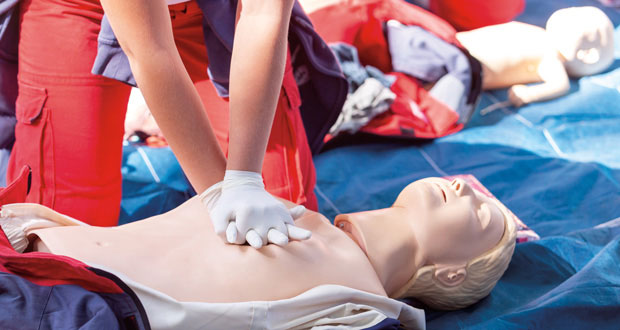First aiders play an important role in providing assistance to casualties, but it’s crucial that their skills are maintained beyond their initial qualification, says Kristin Guzder, Health and Safety Learning Designer at High Speed Training
Under the Health and Safety (First-Aid) Regulations 1981 (the First Aid Regulations), employers have a legal duty to ensure adequate and appropriate first aid equipment, facilities, and personnel are provided. This is a legal requirement and ensures that if someone is taken ill or injured, they can receive immediate assistance. Employers may delegate this duty to facility managers, who therefore must understand how to determine what must be provided to ensure compliance.
A first aid needs assessment takes into consideration various factors, including the nature of activities that take place and the hazards and risks. It’s important to note that there aren’t set rules on what first aid provision is required for different industries. The level of provision will be more extensive for a higher-level hazard environment (such as a manufacturing facility) compared to a low-hazard one (such as a commercial office). Instead, the person carrying out the assessment must determine what will be required.
The Health & Safety Executive (HSE) has suggested the numbers of first aid personnel that need to be available at all times when people are at work. Where work activities are low level hazards and there are between 25 and 50 staff, then at least one Emergency First Aid at Work (EFAW) first aider is recommended. If this increases to over 50 people, it’s advised that there’s at least one first aider trained in First Aid at Work (FAW) for every 100 people. If a workplace has higher level hazards present and between five to 50 employees, at least one first aider trained in FAW or EFAW (depending on the type of injuries that may be sustained) is suggested. When the number of employees exceeds 50, it’s suggested that there’s at least one first aider trained in FAW for every 50 people.
First Aid Qualifications
There are two main types of first aid qualifications: First Aid at Work (FAW) and Emergency First Aid at Work (EFAW). The first aid needs assessment will show whether a first aider (or several) is required, and whether they need to be trained in FAW or EFAW. Both FAW and EFAW qualifications must involve a practical training element, although some may also incorporate an e-learning component (blended learning).
There are several differences between the two qualifications. The EFAW course is described by the HSE as training that ‘enables a first-aider to give emergency first aid to someone who is injured or becomes ill while at work’. It includes fewer topics than the FAW course, and is designed to qualify trainers to respond confidently to emergency medical situations. It must involve a minimum of six hours of training and assessment over at least one day, following the syllabus set out in the HSE’s guidance First aid at work: The Health and Safety (First-Aid) Regulations 1981.
For the FAW course, the HSE describe it as meeting the same requirements as EFAW training but it ‘also equips the first-aider to apply first aid to a range of specific injuries and illnesses’. It is more extensive and is designed to qualify trainers to respond to a range of situations, not just ones which are classed as emergencies. FAW qualifications must involve at least 18 hours of training and be run over a minimum of three days (including the assessment).
Workplace First Aid Awareness
Although not a legal requirement, it’s good practice for all staff to take a workplace first aid course. Basic first aid skills can be taught through e-learning, provided the individual doesn’t need to become a qualified first aider. For example, someone having a cardiac arrest needs immediate CPR. This is a time sensitive medical emergency and so if there isn’t a qualified first aider available to administer CPR, whoever is nearby will need to quickly respond. With the right knowledge, anyone can recognise when someone needs CPR and be able to give chest compressions (hands-only CPR).
Maintaining First Aid Skills
First aid skills should be maintained so that the individual continues to feel confident in their ability to give assistance. It also ensures they are aware of any changes to first aid guidance. This is essential for first aiders and strongly recommended for those who only have an awareness level of knowledge. Some online workplace first aid training that’s intended for individuals who aren’t first aiders has a recommended renewal period of three years. However, how often individuals refresh their knowledge may vary depending on the premises.
The First Aid Regulations require qualified first aiders to undergo practical requalification training every three years. This must be arranged before the first aider’s certification expires – once it does, they are no longer considered a qualified first aider. As a minimum, both must cover the same content as the initial courses. FAW requalification courses must be at least two days long and EFAW one day.
It is also recommended that first aiders undergo annual refresher training between qualifications. Annual refresher training doesn’t need to be in-person; instead, an online First Aid at Work Refresher or Emergency First Aid at Work Refresher course may be suitable.





